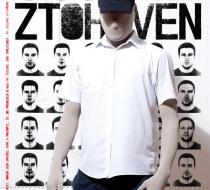"Citizen K"/“Občan K”: Idendity Swap Favorite
On 17 June 2007, a horrific vision was offered to the viewers of the Czech morning program Panorama: instead of idyllic hills, the image of a mushroom cloud was broadcast by a weather camera installed in the Krkonoše mountains, which caused a brief moment of panic in a country that is regularly agitated by debates on nuclear power. The panic wasn’t justified. Calm rapidly returned when the fraud was discovered: not a nuclear catastrophe, but a video hack orchestrated by the Prague-based artists in Ztohoven.[1]
It is difficult to find a Czech, especially among young people, who haven’t heard of the “atomic explosion” of 17 June 2007. The group, made up of twenty members, was already known due to its other surprising and effective artistic projects. But none of those projects, even the famous heart-shaped projection on the Prague Château when President Václav Havel left office, caused so much controversy.
When people speak of Ztohoven these days, they speak about their new project, Citizen K. This is a film that will be screened in Czech cinemas in January. It’s title, Občan K., is a bit of bravura that loans itself to many interpretations. It evokes the bureaucratic labyrinth with which Josef K, the famous protagonist of Kafka’s novel The Trial, finds himself confronted; the cult film Citizen Kane; Václav Havel, whose political career was the subject of a documentary titled Občan Havel; and, of course, the Czech word občanka, which is short for Občanský Průkaz (the Czech identity card).
The film comes from an artistic project in which two members of Ztohoven demonstrate in an incredible way the absurdity of the Czech bureaucratic system. In 2010, both of them usurped the same identity for six months: the identity of an individual who never existed! With the help of biometric technology, they combined their two faces and thereby created a new person whose identity allowed them to procure a perfectly legal passport, vote in an election, get married, and obtain a permit to carry a firearm. This is the first time since the mushroom cloud affair that a project by Ztohoven has provoked as much indignation as fascination: it even caused the arrest of one of the project’s initiators, David Hons, alias Roman Týc.
This ability to divide public opinion has to do with their impressive manner of promoting themselves: though their performances often take place in public, the members of the collective – with the exception of co-founder David Hons – manage to keep their anonymity. When they appear in public, they always use pseudonyms that are obviously not real names. They are always playing on words that mix English and Czech: for example, Roman Týc is “Romantic,” Dan Gerous is “Dangerous,” and Anna Bolická is a reference to anabolic steroids.
But even if they use pseudonyms, the artists in Ztohoven scorn journalists. Few have managed to meet one or several of them in person.
Klára Bulantová has followed the authorities' reaction to Občan K. She says that “in a liberal and democratic society, it shouldn’t happen that someone is in custody for an artistic performance, such as the one by Týc. What’s worse is that he is not an isolated case.
This political science student has an overall view of Ztohoven’s “style.” She says, “I do not know all of their projects, but among the ones that I know, I prefer the one called Violated Consciousness. In 2003, in the space of a single day, they covered all the illuminated advertisements in the Prague metro system with their own posters. I find the other projects of Ztohoven to be original, but, to me, they are often performances for the sake of performances. But this is the vicious circle in the evaluation of art.”
Adela Zichačková, 23, believes certain group positions to be “naïve, immature and childish,” but she nevertheless approves of Ztohoven’s projects overall.
“You can thank them for having opened the discussion about this question,” she says. “Moreover, I find the forms of expression chosen by these artists to get their message through to be very pertinent.”
She finds it scandalous that Roman Týc has been treated like a criminal. “They are objecting to artistic freedom and freedom of speech!” she says.
Another Prague resident, a film student who wished to remain anonymous, shares this view. “It would be really frustrating if no one rebelled against the system, no matter how lame, ridiculous, or simplistic that rebellion is,” she said. Today, if you want to get the public’s attention, you have to take actions that create a polemic. That is exactly the reason why subversive art is successful!”
[1] In Czech, Ztohoven means "a hundred pieces of shit."








